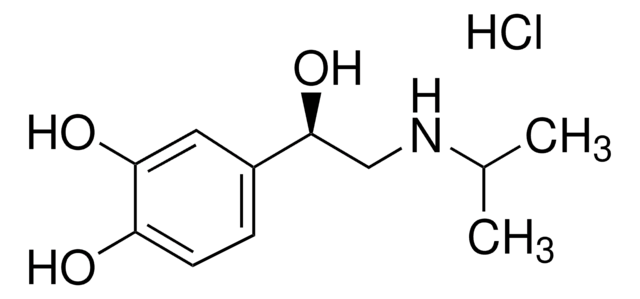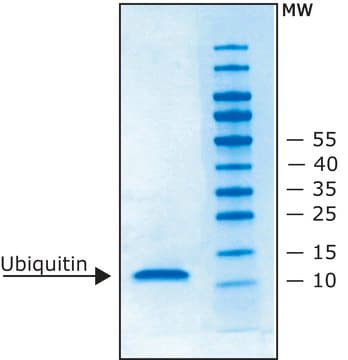SRP6133
Ubiquitin-K48 human
recombinant, expressed in E. coli, ≥85% (SDS-PAGE)
Iniciar sesiónpara Ver la Fijación de precios por contrato y de la organización
About This Item
UNSPSC Code:
12352200
NACRES:
NA.32
Productos recomendados
biological source
human
recombinant
expressed in E. coli
assay
≥85% (SDS-PAGE)
form
liquid
mol wt
8.732 kDa
packaging
pkg of 500 μg
NCBI accession no.
shipped in
dry ice
storage temp.
−70°C
Gene Information
human ... RPS27A(6233)
General description
Ubiquitin is a small polypeptide that can be conjugated via its C-terminus to amine groups of lysine residue on target proteins. This conjunction is referred to as monoubiquitylation. Additional ubiquitin moieties can be subsequently conjugated to this initial ubiquitin, utilizing any one of the seven lysine residues on the surface of ubiquitin. The formation of these ubiquitin chains is referred to as polyubiquitylation. This tag-free recombinant form of human ubiquitin is engineered to have all available lysines mutated to arginines, except at position 48. This molecule, therefore, can only form polyubiquitin chains of K48 linkage type. Covalent attachment of ubiquitin to other proteins serves various functions, but its major role is to target cellular proteins for destruction. Cellular components that activate, transfer, remove, or simply recognize ubiquitin number in the hundreds, perhaps even in the thousands. In light of this complexity the ubiquitin pathway is ideal for a systems biology approach. Ubiquitin plays a very important role in regulated non-lysosomal ATP dependent protein degradation. The Ub-proteasome proteolytic pathway, which is a complex process, is implicated to be of great importance for regulating numerous cellular processes.
Physical form
4 mg/mL in 50 mM Tris, pH 7.5, 150 mM NaCl, 10% glycerol.
Preparation Note
Centrifuge the vial prior to opening.
Storage Class
13 - Non Combustible Solids
wgk_germany
WGK 3
flash_point_f
Not applicable
flash_point_c
Not applicable
Certificados de análisis (COA)
Busque Certificados de análisis (COA) introduciendo el número de lote del producto. Los números de lote se encuentran en la etiqueta del producto después de las palabras «Lot» o «Batch»
¿Ya tiene este producto?
Encuentre la documentación para los productos que ha comprado recientemente en la Biblioteca de documentos.
Nuestro equipo de científicos tiene experiencia en todas las áreas de investigación: Ciencias de la vida, Ciencia de los materiales, Síntesis química, Cromatografía, Analítica y muchas otras.
Póngase en contacto con el Servicio técnico






